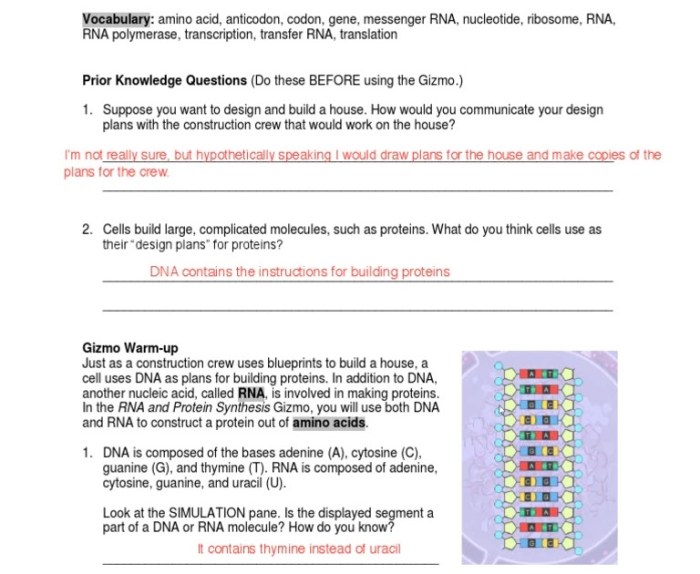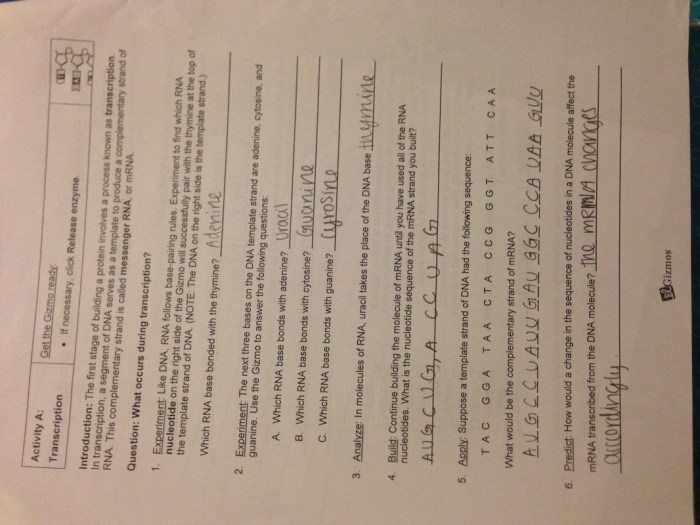Student exploration rna and protein synthesis gizmo answer key – Embark on a scientific journey with the Student Exploration: RNA and Protein Synthesis Gizmo Answer Key, an interactive tool that unlocks the mysteries of genetic expression. This key provides a comprehensive guide to the Gizmo’s features and functions, empowering educators and students alike to delve into the intricate processes of RNA and protein synthesis.
Through engaging simulations and detailed explanations, the Gizmo Answer Key unveils the complexities of gene transcription and translation, showcasing the crucial roles of DNA, RNA, and proteins in the synthesis of life’s building blocks.
Overview of Student Exploration: RNA and Protein Synthesis Gizmo

The Student Exploration: RNA and Protein Synthesis Gizmo is an interactive simulation that allows students to explore the process of RNA and protein synthesis. The Gizmo is designed to help students understand the role of DNA, RNA, and proteins in the production of new cells.
The objectives of the Gizmo are to:
- Explain the concept of RNA and protein synthesis.
- Describe the role of DNA, RNA, and proteins in this process.
- Discuss the steps involved in transcription and translation.
- Provide students with an opportunity to explore the process of RNA and protein synthesis in a virtual environment.
Key Concepts: Student Exploration Rna And Protein Synthesis Gizmo Answer Key
RNA and protein synthesis are essential processes for all living cells. RNA is a type of molecule that carries genetic information from DNA to the ribosome, where proteins are made. Proteins are essential for the structure and function of cells.
The process of RNA and protein synthesis can be divided into two main steps:
- Transcription: In transcription, the DNA molecule is copied into a messenger RNA (mRNA) molecule.
- Translation: In translation, the mRNA molecule is used to create a protein.
Gizmo Features

The Student Exploration: RNA and Protein Synthesis Gizmo includes a number of features that allow students to explore the process of RNA and protein synthesis in a virtual environment.
- A virtual DNA molecule: Students can use the virtual DNA molecule to create different mRNA molecules.
- A virtual ribosome: Students can use the virtual ribosome to translate mRNA molecules into proteins.
- A variety of tools and resources: The Gizmo includes a variety of tools and resources that can help students learn about the process of RNA and protein synthesis.
Classroom Implementation

The Student Exploration: RNA and Protein Synthesis Gizmo can be used in a variety of ways in the classroom.
- As a standalone activity: The Gizmo can be used as a standalone activity to help students learn about the process of RNA and protein synthesis.
- As part of a larger unit: The Gizmo can be used as part of a larger unit on genetics or cell biology.
- As a review tool: The Gizmo can be used as a review tool to help students prepare for exams.
Student Learning Outcomes
After using the Student Exploration: RNA and Protein Synthesis Gizmo, students should be able to:
- Explain the concept of RNA and protein synthesis.
- Describe the role of DNA, RNA, and proteins in this process.
- Discuss the steps involved in transcription and translation.
- Apply their knowledge of RNA and protein synthesis to solve problems.
Answers to Common Questions
What is the purpose of the Student Exploration: RNA and Protein Synthesis Gizmo?
The Gizmo is an interactive simulation that allows students to explore the processes of RNA and protein synthesis.
What are the key concepts covered in the Gizmo?
The Gizmo covers the concepts of DNA, RNA, proteins, transcription, and translation.
How can the Gizmo be used in the classroom?
The Gizmo can be used to support student learning in a variety of ways, including as a demonstration tool, a hands-on activity, or a formative assessment.